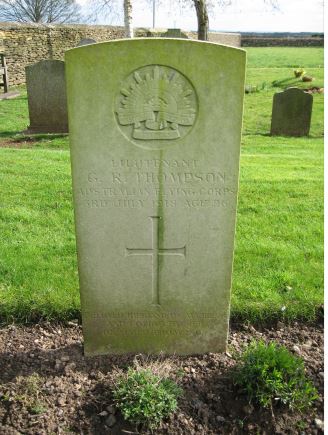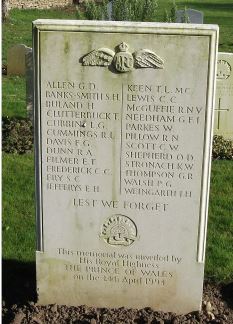7th Training Squadron, Australian Flying Corps

George Robert Thompson was born at South Melbourne, Victoria, Australia on 8 August 1891, the son of Alexander J and Mary Thompson, of St Kilda, Victoria. He was a married man by the time of the Great War, his next of kin being Mrs M L Thompson of Vacuna. 26 Faulkener Street, St Kilda.
George was not a newcomer to the military when he attested for service in the Great War on 4 May 1917. He described his occupation as ‘officer permanent forces’ based at Fortress Queenscliff. He had joined the Australian Military Forces on 1 October 1911, as a Lieutenant and on 1 August 1913 became a Second Lieutenant in the Royal Australian Garrison Artillery, being promoted to full Lieutenant on 30 October 1914, based at Fortress Queenscliffe.
Following attestation, he left Sydney on 10 May 1917 aboard the transport Marathon (A74), with the March 1917 Australian Flying Corps (AFC) Enlistment. He arrived in the UK at Plymouth on 20 July 1917, as part of 9th Squadron AFC Reinforcement. On the following day he was located at No1 and 3 Camp Depots, Parkhouse and on 16 October 1917 was promoted to Flying Officer (Pilot).
His next posting was to 30th Training Squadron, Tern Hill, Shropshire and after a short stay at Farnborough he arrived at Boulogne on 27 January 1918, joining 4 Squadron, AFC.
After about seven weeks on the Western Front he returned to the UK, on 9 March 1918, to 7th Training Squadron, Leighterton, Gloucestershire. On 29 April 1918 he was admitted to Beaufort War Hospital, Bristol (part of 2nd Southern General Hospital) for an operation to relieve breathing difficulties whilst flying at high altitude. He returned to Leighterton on 5 June 1918.
George Thompson was an experienced pilot, with about 110 hours flying time logged. On 3 July he went aloft in a RE8 aircraft (serial number E140), taking with him Air Mechanic First Class Sydney Harold Banks-Smith, as armourer. The RE8 (nickname ‘Harry Tate’) was principally employed as a spotter for artillery, however, it was also used in a bombing role. Neither the Thompson nor Banks-Smith’s service papers give much detail as to the accident which brought an end to their lives. Evidently the aircraft was diving onto a target (possibly practising bombing) when it either caught fire or burst into flames upon impact with the ground. Both men were killed instantly: Thompson suffered a fractured skull, right thigh and left leg and had severe abdominal injuries, plus extensive burns. He was about a month short of his 27th birthday.
Lieutenant George Thompson was buried, with military honours, along with Air Mechanic First Class Banks-Smith, at Leighterton Church Cemetery on 5 July 1918 and a CWGC headstone now marks his grave.


Researched by Graham Adams 11 January 2018
